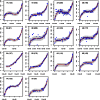Genotyping by Sequencing Using Specific Allelic Capture to Build a High-Density Genetic Map of Durum Wheat
- PMID: 27171472
- PMCID: PMC4865223
- DOI: 10.1371/journal.pone.0154609
Genotyping by Sequencing Using Specific Allelic Capture to Build a High-Density Genetic Map of Durum Wheat
Abstract
Targeted sequence capture is a promising technology which helps reduce costs for sequencing and genotyping numerous genomic regions in large sets of individuals. Bait sequences are designed to capture specific alleles previously discovered in parents or reference populations. We studied a set of 135 RILs originating from a cross between an emmer cultivar (Dic2) and a recent durum elite cultivar (Silur). Six thousand sequence baits were designed to target Dic2 vs. Silur polymorphisms discovered in a previous RNAseq study. These baits were exposed to genomic DNA of the RIL population. Eighty percent of the targeted SNPs were recovered, 65% of which were of high quality and coverage. The final high density genetic map consisted of more than 3,000 markers, whose genetic and physical mapping were consistent with those obtained with large arrays.
Conflict of interest statement
Figures



Similar articles
-
Conversion of array-based single nucleotide polymorphic markers for use in targeted genotyping by sequencing in hexaploid wheat (Triticum aestivum).Plant Biotechnol J. 2018 Apr;16(4):867-876. doi: 10.1111/pbi.12834. Epub 2017 Oct 23. Plant Biotechnol J. 2018. PMID: 28913866 Free PMC article.
-
Sequence-based SNP genotyping in durum wheat.Plant Biotechnol J. 2013 Sep;11(7):809-17. doi: 10.1111/pbi.12072. Epub 2013 May 3. Plant Biotechnol J. 2013. PMID: 23639032
-
Unlocking the novel genetic diversity and population structure of synthetic Hexaploid wheat.BMC Genomics. 2018 Aug 6;19(1):591. doi: 10.1186/s12864-018-4969-2. BMC Genomics. 2018. PMID: 30081829 Free PMC article.
-
A high-density, SNP-based consensus map of tetraploid wheat as a bridge to integrate durum and bread wheat genomics and breeding.Plant Biotechnol J. 2015 Jun;13(5):648-63. doi: 10.1111/pbi.12288. Epub 2014 Nov 26. Plant Biotechnol J. 2015. PMID: 25424506
-
Lessons from the sequence of human chromosome 22.Ernst Schering Res Found Workshop. 2002;(36):31-50. doi: 10.1007/978-3-662-04667-8_3. Ernst Schering Res Found Workshop. 2002. PMID: 11859563 Review. No abstract available.
Cited by
-
Genome-wide association analysis of tan spot disease resistance in durum wheat accessions from Tunisia.Front Genet. 2023 Oct 25;14:1231027. doi: 10.3389/fgene.2023.1231027. eCollection 2023. Front Genet. 2023. PMID: 37946749 Free PMC article.
-
GeCKO: user-friendly workflows for genotyping complex genomes using target enrichment capture. A use case on the large tetraploid durum wheat genome.Plant Methods. 2024 Jul 13;20(1):103. doi: 10.1186/s13007-024-01210-6. Plant Methods. 2024. PMID: 39003455 Free PMC article.
-
QTL Mapping of Fiber-Related Traits Based on a High-Density Genetic Map in Flax (Linum usitatissimum L.).Front Plant Sci. 2018 Jul 17;9:885. doi: 10.3389/fpls.2018.00885. eCollection 2018. Front Plant Sci. 2018. PMID: 30065730 Free PMC article.
-
Toward Genomics-Based Breeding in C3 Cool-Season Perennial Grasses.Front Plant Sci. 2017 Jul 26;8:1317. doi: 10.3389/fpls.2017.01317. eCollection 2017. Front Plant Sci. 2017. PMID: 28798766 Free PMC article. Review.
-
Conversion of array-based single nucleotide polymorphic markers for use in targeted genotyping by sequencing in hexaploid wheat (Triticum aestivum).Plant Biotechnol J. 2018 Apr;16(4):867-876. doi: 10.1111/pbi.12834. Epub 2017 Oct 23. Plant Biotechnol J. 2018. PMID: 28913866 Free PMC article.
References
-
- Kilian B, Özkan H, Pozzi C, Salamini F. Domestication of the Triticeae in the Fertile Crescent. Genetics and Genomics of the Triticeae. 2009. pp. 81–119. 10.1007/978-0-387-77489-3_3 - DOI
-
- Dvorak J, Luo MC, Yang ZL, Zhang HB. The structure of the Aegilops tauschii genepool and the evolution of hexaploid wheat. Theor Appl Genet. 1998;97: 657–670. 10.1007/s001220050942 - DOI
Publication types
MeSH terms
LinkOut - more resources
Full Text Sources
Other Literature Sources

